
What Should Be Included in a SaaS Master Service Agreement?
Table of Contents ToggleWhat Is a Master Service Agreement and Why...
Back
Back
Search for Keywords...
Blog

Table of Contents
Understanding SaaS (Software as a Service) contracts is essential for any organization leveraging cloud-based software solutions. These agreements come with unique considerations that differ from traditional software licenses, often involving subscription-based terms, regular updates, and defined usage rights. For companies looking to manage their SaaS portfolios effectively, knowing how to navigate these contracts can make a significant impact on cost management, compliance, and strategic decision-making.
A SaaS contract is a legally binding agreement between a service provider and the customer, detailing the terms under which the software is accessed and used. Unlike perpetual software licenses where the software is bought and owned outright, SaaS contracts involve subscription-based models that provide customers with ongoing access to the service over a specified period.
These contracts typically outline:
Understanding these key components helps businesses manage their SaaS environments more effectively, ensuring that agreements align with operational goals and minimize potential risks.
4 Need-to-Know SaaS Stats for Procurement Leaders
Learn MoreSaaS agreements are essential for defining the relationship between service providers and customers, outlining clear rights and obligations. Here’s why they matter:
A well-crafted SaaS agreement supports compliance, minimizes risks, and offers better control over technology investments.
SaaS contracts include various components and clauses that outline the obligations, rights, and expectations of both the service provider and the customer. These ensure clarity, reduce risk, and protect the interests of both parties. Check out our SaaS agreement checklist for more.
These clauses define who owns the data created, stored, or processed using the SaaS product. It specifies the rights the customer has over their data and ensures the provider cannot use it beyond agreed-upon purposes.
The data security section outlines how the provider protects customer data, detailing measures like encryption, access controls, and compliance with security standards (e.g., SOC 2). It helps customers understand their data’s safety and potential risks.
Limitation of liability sets a cap on the provider’s financial responsibility in case of service failures or data breaches. This clause protects the provider from excessive financial exposure while informing the customer of potential compensation limits.
This section defines how customers can use the software, including user limits, permitted use cases, and geographic restrictions. It ensures clarity on what the customer can and cannot do under the contract.
This covers the cost of using the service, billing frequency, and conditions for price changes.
Outlines additional fees for specific features beyond the standard subscription. It helps customers budget for optional add-ons.
Flat-rate pricing sets a fixed price for unlimited use within specified parameters, simplifying budget management.
Per-active-user pricing charges based on the number of users who actively use the service during a billing period, providing cost flexibility.
Per-user pricing charges a set fee for each user, offering predictability based on user count.
Multi-level pricing structures offer varying levels of features and services at different price points, accommodating a range of needs and budgets.
This setup charges according to actual usage – or consumption– which is beneficial for customers with fluctuating service needs.
These clauses specify the contract’s duration, renewal processes, and conditions under which either party can terminate the agreement. It ensures transparency and prepares both sides for contract end scenarios.
The SLA details performance expectations, such as uptime guarantees and response times for support. It holds the provider accountable for service reliability.
This clause clarifies user permissions, access levels, and any restrictions on who can use the SaaS platform, preventing unauthorized usage.
This describes the type and level of support available, including support hours, response times, and escalation procedures.
Warranties are the provider’s promises about the service’s functionality and reliability, giving customers assurance about the software’s quality.
This section sets clear performance metrics, such as loading speeds or data processing times, ensuring the service meets minimum standards.
Intellectual property rights clauses protect the ownership rights of the provider over the software while detailing any rights the customer has related to modifications or integrations.
Establishes common language, ensuring both parties understand specific terms used throughout the contract.
Explains what the SaaS product offers, including core features and limitations, setting clear expectations.
These clauses outline how conflicts will be resolved, whether through arbitration, mediation, or court proceedings.
This portion emphasizes the provider’s obligations regarding data protection and compliance with relevant laws, giving customers peace of mind about data safety.
SaaS agreements come in various forms, each tailored to specific aspects of software use and management. Understanding these different types helps organizations better manage relationships, protect assets, and maintain compliance.
The Terms of Use set the groundwork for how customers can use the service. This agreement includes permitted use, user obligations, and restrictions. It helps protect the SaaS provider from misuse and clarifies user responsibilities.
An SLA is both a type of contract and a component within larger agreements. It defines performance metrics, such as uptime guarantees and support response times, to ensure the service meets established standards. This contract type sets clear expectations and holds the provider accountable for delivering agreed service levels.
IP agreements cover the ownership and rights of the SaaS product and any related materials. This includes clauses that ensure the provider retains IP rights while outlining any rights granted to the customer for use or modification.
An NDA ensures that confidential information shared between parties is protected. For SaaS, this often means securing proprietary business information, customer data, and sensitive project details, preventing unauthorized disclosure.
This defines the terms under which the customer subscribes to the SaaS service, including payment terms, subscription duration, and renewal conditions. It ensures both parties understand their financial and service obligations.
A licensing agreement grants the customer specific rights to use the SaaS product under defined conditions. This can include limitations on copying, modifying, or distributing the software, ensuring compliance with legal and usage boundaries.
These agreements enable third-party entities to market and sell the SaaS product. These contracts outline pricing, distribution rights, and responsibilities, helping expand the SaaS provider’s reach while maintaining brand and service quality.
This is set up when one party agrees to refer potential customers to a SaaS provider in exchange for a fee or commission. This contract defines the referral process, compensation, and expectations for both parties.
These agreements focus on how customer data is collected, used, stored, and protected. Privacy policies ensure compliance with data protection regulations. Meanwhile, security policies outline the provider’s commitment to safeguarding customer data.
An EULA grants customers the right to use the SaaS product while defining usage limits and responsibilities. It protects the provider’s ownership and clarifies the user’s permissions.
This agreement covers the structure for custom software development services provided alongside a SaaS product. It details project phases, timelines, deliverables, and payment terms, ensuring transparency and alignment on expectations.
These contracts in SaaS companies outline terms with employees, including confidentiality, IP rights, and employment conditions. These help secure company IP and maintain internal data protection.
These agreements are relevant to SaaS companies looking to formalize their shareholders’ rights and obligations. They cover voting rights, profit distribution, and management roles, ensuring all parties are aligned on business strategy and governance.
SaaS contracts come with unique challenges that can impact businesses if not properly managed. Overcoming these issues is essential for ensuring seamless SaaS operations and minimizing risks.
Dealing with SaaS contracts can be complex, especially when balancing cost, service quality, and compliance. Providers may resist changing standard terms, making it hard for customers to secure favorable conditions. To ensure beneficial terms, effective negotiation requires:
Data security and privacy are major concerns in SaaS contracts, as sensitive information is often stored and processed by third-party providers. The challenge lies in ensuring that providers comply with stringent data protection measures, including encryption and secure access protocols. Addressing this involves negotiating robust security clauses and ensuring alignment with both parties’ data handling expectations.
IP issues arise when there is ambiguity over who owns developed or customized software features. Ensuring clear Intellectual Property clauses is critical for protecting both the provider’s and customer’s rights. The challenge lies in preventing conflicts over ownership while fostering a mutually beneficial arrangement.
Managing contract versions is essential for clarity, especially when updates or amendments are made. Without strict version control, businesses risk referencing outdated terms, leading to misunderstandings or compliance issues. Implementing a system for tracking revisions can help maintain consistency and transparency.
Organizations often juggle hundreds SaaS contracts, as you can see from the average portfolio size below. That makes it difficult to keep track of individual terms, renewal dates, and obligations. This can lead to missed renewals, unexpected price increases, or unmet contract terms. Solutions include using contract management tools and regular audits to manage these volumes efficiently.
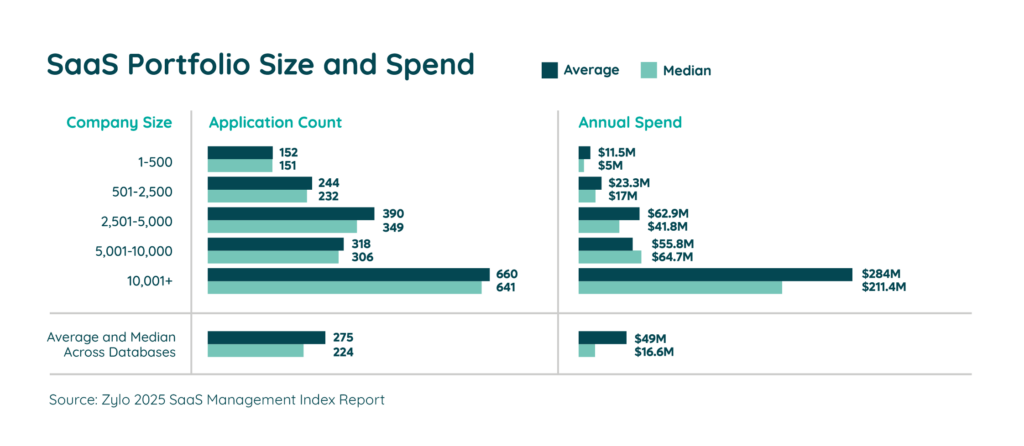
It can be a challenge to track performance against the terms outlined in SLAs and other contract elements. Businesses need to ensure providers meet service expectations to avoid disruptions. Establishing KPIs and monitoring tools helps organizations verify contract compliance and service quality.
Poor communication between departments handling SaaS contracts can lead to oversights, such as unaligned contract expectations or duplicated software licenses. Coordinating cross-department communication and centralizing contract management practices are key to preventing these issues.
Compliance with data privacy laws like GDPR and CCPA presents a significant challenge for SaaS contracts, especially for businesses operating across regions. Ensuring that contracts align with local data privacy regulations requires careful drafting and regular updates to avoid potential legal and financial penalties.
Effective SaaS contract management ensures compliance, maintains service quality, and optimizes costs. Proper management practices help organizations stay on top of contract terms, renewal dates, and any obligations that affect their SaaS portfolio. Below are a few considerations as you go about day-to-day contract management.
A centralized contract repository, like Zylo’s Contract Center, is essential for efficient SaaS contract management. By storing all contracts in one place, organizations can streamline access, improve oversight, and reduce the risk of missing key deadlines or obligations. Cloud-based contract management software can also enhance collaboration and version control.
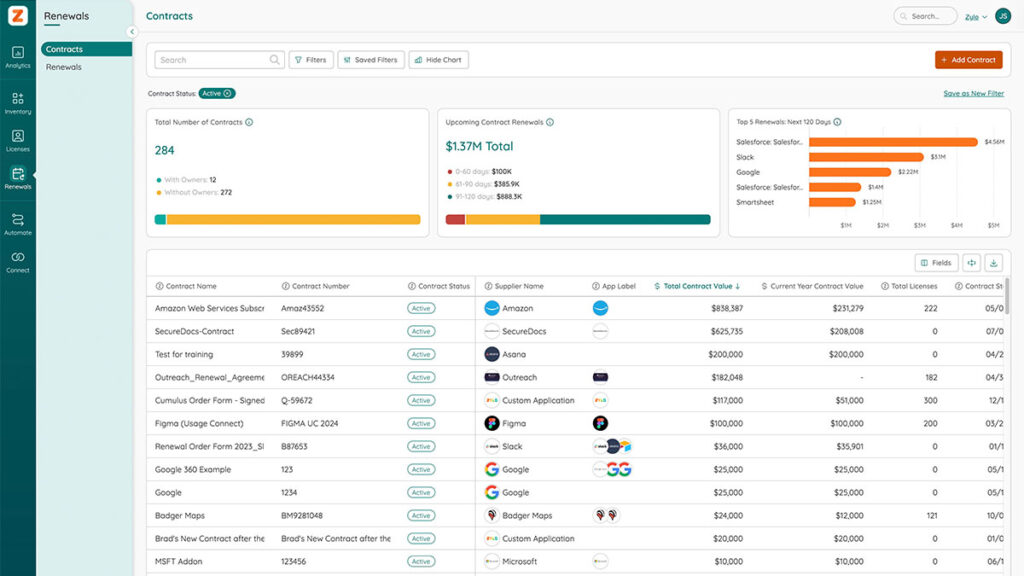
Tracking renewals automatically helps businesses avoid missed deadlines that can result in unexpected service disruptions or price increases. Implementing alerts and automated workflows ensures that contract renewals are reviewed and negotiated well in advance, providing an opportunity for cost management and strategic changes.

Conducting regular contract audits allows businesses to evaluate the terms and performance of existing SaaS agreements. This helps identify areas for renegotiation, ensure SLAs are being met, and verify that the services align with current business needs. Regular audits also aid in identifying unused or underutilized subscriptions, helping reduce unnecessary expenses.
Exchanging information between departments is vital for managing SaaS contracts. Ensuring that all teams, including IT, procurement, and legal, are informed about contract details minimizes the risk of miscommunication and helps align organizational goals. Establishing designated points of contact for contract management enhances transparency and accountability.
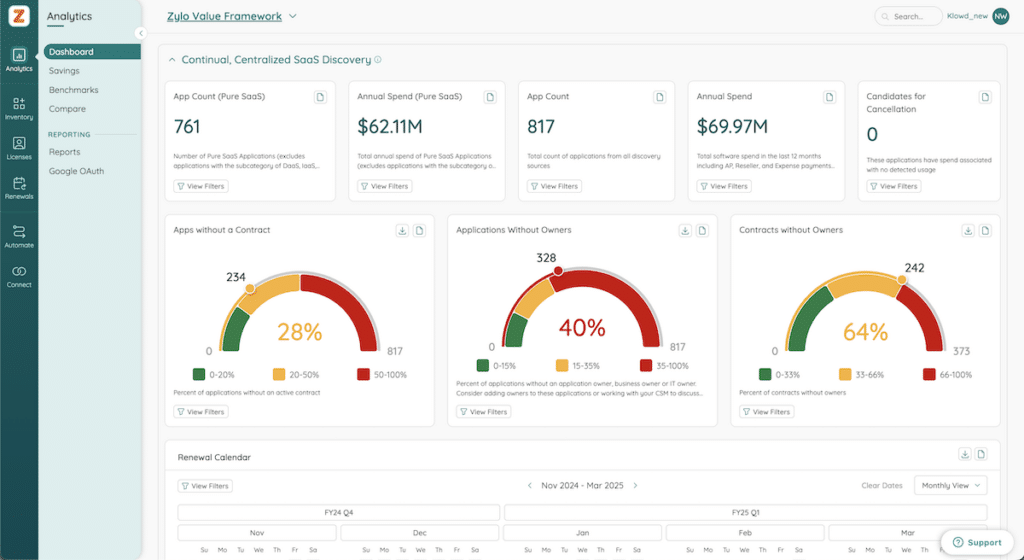
Staying compliant with legal requirements and following best practices for contract management help protect organizations from potential legal issues and improve contract efficiency.
SaaS agreements should fit a specific business need. Negotiating tailored clauses related to data ownership, service levels, and liability limits helps protect the customer’s interests and creates flexibility. This practice avoids “one-size-fits-all” terms that might not align with the organization’s goals or risk profile.
SaaS contracts often involve parties from different geographic regions, making jurisdictional issues significant. Including clauses that specify the governing law and jurisdiction for resolving disputes is important for preventing legal complications. Companies should collaborate with legal counsel familiar with international laws to navigate these challenges effectively.
Ensuring compliance with industry standards, such as ISO 27001 for information security or HIPAA for healthcare, is essential for specific sectors using SaaS services. Contracts should include clauses that require the provider to adhere to relevant industry certifications and standards, protecting the organization from potential regulatory penalties.
Providing regular training for contract management teams ensures that staff stay informed about legal changes, best practices, and efficient contract management processes. This helps reduce errors, improve negotiation outcomes, and maintain strong vendor relationships.
Defining clear performance metrics in SLAs helps manage expectations and measure contract success. These metrics may include uptime guarantees, response times, and support service levels. Ensuring these are well-documented and tracked provides leverage for enforcing contract terms and maintaining service quality.
Managing SaaS contracts efficiently requires leveraging the right technologies. SaaS contract management tools enhance oversight, streamline processes, and ensure compliance.
Cloud storage allows organizations to securely store and access contracts from anywhere. This setup ensures that all teams can collaborate and reference contracts in real time, eliminating the need for physical documents and reducing the risk of data loss.
Advanced search functions help teams quickly locate specific contracts or clauses. This feature is crucial when managing high volumes of contracts and finding details for audits, negotiations, or compliance checks.
Automatic alerts for key dates, such as renewals and payment deadlines, help organizations avoid missed opportunities for renegotiation and prevent service interruptions. This feature ensures proactive management of contract lifecycles.
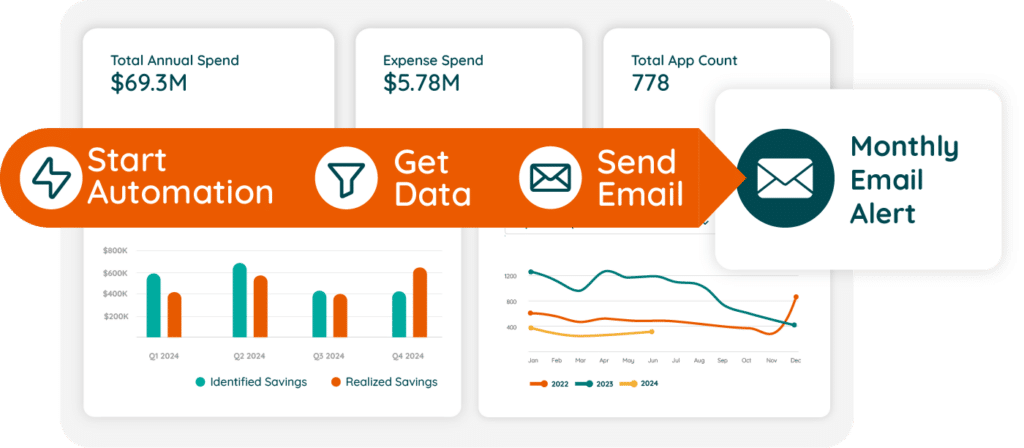
Integrating with existing systems, such as CRM and ERP platforms, streamline workflows by connecting contract data with other business processes. This helps maintain alignment across departments and reduces manual input errors.
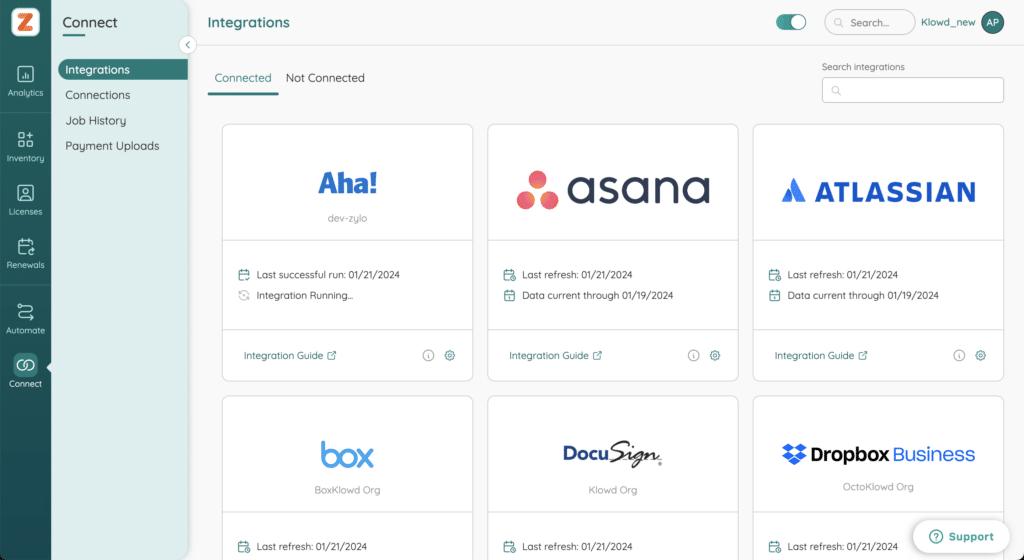
As technology advances and regulations evolve, the landscape of SaaS contracts will undergo significant changes. Understanding these shifts helps organizations stay prepared and adaptable.
Rapidly developing technologies such as artificial intelligence (AI) and blockchain are set to transform SaaS contract management. AI can enhance contract analysis by quickly identifying risks and opportunities within agreements, while blockchain can provide tamper-proof audit trails for greater transparency and trust.
SaaS contracts must adapt to regularly updated data protection standards. Future agreements will likely include more detailed clauses on data privacy, cross-border data transfer policies, and user consent to align with stricter global regulations.
As user expectations shift, SaaS agreements will increasingly prioritize transparency and simplicity. Contracts may become more user-friendly, with concise language and straightforward terms that are easier to understand, making it simpler for clients to navigate and manage them.
Sustainability considerations are becoming more prevalent. SaaS agreements may begin to include clauses that address the provider’s commitment to eco-friendly practices, such as energy-efficient data centers and carbon offset initiatives.
SaaS contract management is essential for maximizing the value of software investments. At Zylo, we understand the importance of effective SaaS contract strategies that align with business goals and ensure compliance. Organizations can optimize their SaaS portfolios and minimize potential risks by leveraging technology and adhering to best practices.
Ready to transform your SaaS contract management strategy? Visit Zylo to learn more.
A SaaS contract is necessary whenever a business engages with a service provider to use cloud-based software. A contract defines usage rights, service expectations, data handling, and more to protect both parties.
While both outline software usage rights, a SaaS agreement covers access to software hosted by the provider and typically includes continuous updates and support. A traditional licensing agreement grants the user the right to use software that is installed and maintained. Differences include:
Negotiating SaaS contracts involves reviewing key terms such as pricing, data ownership, SLAs, and liability clauses. It’s important to:
Data ownership terms specify whether the customer or the SaaS provider holds the rights to the data processed within the service. Most SaaS agreements ensure that the customer retains data ownership while the provider is responsible for data security and management.
Common billing models include:
To ensure data security and compliance:
Termination clauses should address the following:
Yes, most SaaS contracts can be customized to include specific clauses related to data handling, SLA terms, and other unique requirements to align with a business’s operational goals.
Contracts should specify how data is handled post-termination. Most agreements include a period for data retrieval, after which data is deleted from the provider’s servers to protect confidentiality.

Table of Contents ToggleWhat Is a Master Service Agreement and Why...

Table of Contents ToggleWhat Is a SaaS Agreement?Why SaaS Agreements Are...

Table of Contents ToggleWhat Is a SaaS Contract?The Importance of SaaS...

Table of Contents ToggleWhat Is a SaaS Contract?The Importance of SaaS...
| Cookie | Duration | Description |
|---|---|---|
| cookielawinfo-checkbox-analytics | 11 months | This cookie is set by GDPR Cookie Consent plugin. The cookie is used to store the user consent for the cookies in the category "Analytics". |
| cookielawinfo-checkbox-functional | 11 months | The cookie is set by GDPR cookie consent to record the user consent for the cookies in the category "Functional". |
| cookielawinfo-checkbox-necessary | 11 months | This cookie is set by GDPR Cookie Consent plugin. The cookies is used to store the user consent for the cookies in the category "Necessary". |
| cookielawinfo-checkbox-others | 11 months | This cookie is set by GDPR Cookie Consent plugin. The cookie is used to store the user consent for the cookies in the category "Other. |
| cookielawinfo-checkbox-performance | 11 months | This cookie is set by GDPR Cookie Consent plugin. The cookie is used to store the user consent for the cookies in the category "Performance". |
| viewed_cookie_policy | 11 months | The cookie is set by the GDPR Cookie Consent plugin and is used to store whether or not user has consented to the use of cookies. It does not store any personal data. |
